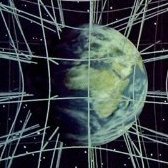Leaderboard
Popular Content
Showing content with the highest reputation on 02/21/25 in all areas
-
1 point
-
No definition of consciousness that includes bees is going to be useful to humans, imo. Stretching it to fit is a mistake. Frankly, I can't think of a definition of consciousness in humans that would be meaningful to us. Are we all automatically conscious because we're human? Are we distinguishing between consciousness and sentience? I have noticed there seems to be a minimum threshold on a combination of intelligence/education/experience, such that you need to know a certain amount before you can even hope to know more. It's that moment for many when "the light bulb comes on", when "things just click", and the human brain suddenly has enough "smarts" to keep it curious and thriving. Some humans never seem to meet this threshold, where your own (consciousness?) becomes self-sustaining and capable of dynamic growth.1 point
-
I know this is more a memoir of growing up than a book about chemistry, but Oliver Sach's book, "Uncle Tungsten", does introduce the reader to chemistry in a way that conveys the fun and fascination. And you pick up some concepts along the way, in a fairly painless way. Kate Biberdorf's "It's Elemental," is also a good beginner's intro.1 point
-
Excellent explanation! Thanks. Ok, so what is a reactant? And they weighed them? Were their scales that precise back then? And I still need to learn what atomic weight is. Phosphoric acid, how did he know it was phosphoric acid? Sorry for so many questions, I'm trying to learn and remember this stuff. Do you know of any good YT videos that explain this? And what is an ion? How do they know it's an ion? Anyway, these explanations are much appreciated.1 point
-
...not to mention how much of the rest of the wealth is facilitated by the idiot part.1 point
-
I do wonder though how much of the "savant" part is facilitated by generational wealth.1 point
-
Indeed so. +1 Because Your document is not Science. In fact it contains many obvious experimental inaccuracies. Proving anything is not the scientific way. A counterexample may or may not disprove something. Over two and thousand years ago Greek philosophers believed that they could sit in the comfortable villas and dream up hypotheses about how the natural world behaves without ever checking to see if their ideas replicated what actually occurred. They were serious wrong in many many respects and it has taken Science thoudands of years to move on to a better ( as in more successful) approach. Unforunately you appear to be trying to tread the same path as those ancient Greeks. So I seriously you do a couple of things. Firstly find out about the Scientific Method, which drives scientific activity. And also findout the difference between an Hypothesis and a Theory. You can ask here at SF about this, I'm sure Phi is bursting to explain this. Secondly ask about some basic understanding of Science in general and Physics in particular to improve your future thinking.1 point
-
By 1875 they had a pretty good idea of how to characterise chemical compounds. Mendele'ev's periodic table came out in 1871. The basic way the c.19th chemists worked was by careful measurements of weight changes. They weighed the reactants and the products and from this were able, eventually, to work out the atomic weight of each element. Once they knew the atomic weights, they could use weight changes during reactions to establish the chemical formula for each substance. It all started back in the time of Lavoiser, at the end of the c.18th (he lost his head in the French Revolution, in fact, poor fellow). He studied combustion, through which he was able to find out things like the fact that when you burned something it absorbed only 20% of the volume of air available. So that told him there were 2 components in air, the 80% component being inert. He called it "azote", from the Greek for lifeless, which is French for nitrogen to this day. He also found the ash from burning phosphorus weighed more than the phosphorus before burning, and that this ash was acid when dissolved in water. So he realised the component of air that reacted had become part of the ash, along with the phosphorus - a chemical compound. Because the ash was acid he called the reacting component of air "oxygene", from the Greek for acid-generating. What he had made was phosphorus pentoxide P₂O₅, and when he dissolved it, he got a solution of phosphoric acid. (Lavoiser was subsequently shown to be wrong in associating oxygen with acidity, when hydrochloric acid was shown not to have any oxygen in it. In modern chemistry, acids are substances that release hydrogen ions, H⁺, in solution. So it was 2 steps forward, one step back.) It was by painstaking experiments like this, carefully weighting reactants and products, or carefully measuring volume changes in the case of gases, that by degrees the identities of chemical elements and compounds and their formulae came to be discovered, from the proportions in which they reacted.1 point
-
OK to start see my reply to this thread Any questions on this ?1 point
-
Pro: He's human and therefore mortal. Con: We’re unlikely to confirm his mortality today.1 point
-
1 point
-
1 point
-
OK, hydrazine. This is N₂H₄, https://en.wikipedia.org/wiki/Hydrazine so made of molecules each of which has 2 atoms of nitrogen, joined by a single chemical bond N-N and with each nitrogen atom also being to joined by a bond to 2 hydrogen atoms. The astronauts and rocket scientists know what it is because it is made for them in a chemical plant, but if your question is how can someone , in principle, test this stuff to confirm its identity, then I think one would probably have a look at its infra-red spectrum. Molecules like this absorb infra red radiation at particular frequencies, according to the atoms present and how they are bonded. (The bonds are stretchy, so if the atoms are pulled apart or pushed together, the bond can be set into vibration, the frequency of which depends on the mass at either end and the strength of the bond. Infra red waves of the exact frequency required can pull or push them in this way and when they do the molecule absorbs some of the radiation, which the spectrometer can detect.) But your more general question is really about analytical chemistry as a whole. This is a big subject. The various forms of spectroscopy, one of which I have described above, play a big role in helping to identify chemical compounds. But there are also other methods which often involve trying to carry out chemical reactions to see what results. Normally this only works when you already have some idea of what you are looking for. I think your last question, about Mg and the significance of the number 12, actually gets us to an excellent starting point for some understanding of chemistry, because it gets us to the Periodic Table of the elements. Here's a link to one I use for reference: https://ptable.com/#Properties Mg is the chemical symbol for magnesium and it is the 12th element in the table. 12 is its "atomic number". And you are right, the atom has 12 electrons, to balance the 12 positively charged protons in its nucleus. Chemistry is all about the electrons in the atom: electrons are what form chemical bonds. The number of electrons in atoms of the various elements determines how each element will behave, chemically. Mendele'ev, who originally designed the Table in the c.19th, did so without knowing this (!). He just observed there were similarities in the chemical behaviour of certain elements and grouped those into columns. So for example, the column at far left with lithium, sodium etc. are all very reactive, soft metals which react with, say chlorine to form white salts with one atom of chlorine per atom of metal. (Common salt NaCl is one example.) The next group, with Mg, Ca etc in it, also form white salts but with two atoms of chlorine per metal atom. So he realised there is something important in common between Li and Na, and between Mg and Ca. The rest of the table was built up in similar fashion, from knowledge of the reactions of elements and the compounds they tended to form. Nowadays we know it is to do with the way electrons build up in layers ("shells") like an onion, as one moves from lighter to successively heavier atoms, so that repeating patterns come back over and over when the shells are similar. This is something we can discuss. Elements with higher atomic number have more mass, so as one reads the table starting at the top left, one gets a progression of successively heavier atoms. The table is divided nowadays into blocks, according to the types of properties one finds in the columns (known as periodic table Groups). Again, this is something we can discuss. If you click on an element in the version of the table I have linked, you will get on the left a rather technical summary of key data but also, probably more interesting to you, a blue link to a Wiki text article all about the element.I suggest having a look at magnesium, since you asked about it, and perhaps also nitrogen, since you asked about hydrazine.1 point
-
Can Trumpism be defeated? Absolutely. Here’s how » Senator Bernie Sanders1 point
-
Matter + antimatter has energy, both before and after annihilation (since energy is conserved), so saying there’s no energy left is incorrect.1 point
-
@Dejan1981 I’d just like to add that there is in fact a way to “split” curvature, though not along the lines of what you suggested. Imagine you have a very small volume - like a very small ball - that is in free fall towards a larger body. One might ask what happens to this ball, and this can be analysed in terms of volume and shape. As it turns out, if the ball free-falls in a vacuum, its total volume remains conserved, and only its shape distorts over time as it approaches the central body. If however the free fall happens inside an energy-momentum distribution (eg in a very strong electromagnetic field), both its shape and its volume will change. The rate at which a test volume in free fall begins to change is encoded in the Ricci tensor Rμν , which, as you might recall, appears directly in the Einstein equations. This is what the vacuum equations physically mean: Rμν=0 means that a small volume in free fall through vacuum is preserved. The shape of the ball is encoded in another object, the Weyl tensor Wμνϵδ , which does not vanish, and which does not appear in the field equations. If the free fall happens in something other than vacuum, the Ricci tensor never vanishes: Rμν=κTμν−κ12gμνT while the Weyl tensor may or may not vanish. EDIT: The last term in the above should have a factor ½, not 12. For some reason I’m unable to edit the LaTeX, and the rendering looks off too. No idea why. The point is this: the full description of the entire spacetime geometry is given by the Riemann tensor, and it so happens that this tensor can always be covariantly decomposed into a linear combination of the Ricci tensor and its trace, as well as the Weyl tensor. This is called the Ricci decomposition. What I wrote above is the geometric interpretation, and you can also give it a more physical one - the Ricci tensor represents curvature due to local sources, whereas the Weyl tensor represents curvature due to distant sources, for example gravitational radiation. So if you want to decompose curvature, this would be a well-defined and observer-independent way to do it.1 point
-
1 point
-
Good question because although the above quote is a true statement it is a pretty poor definition at best and misleading at worst. So I suggest we should start by considering what a substance is. Objects can be material objects, like spoons, plates, cups, flames, tree trunks, amd so on. Objects can also be non material objects like light, shadow, magnetic fields and so on. Material objects are made of substances, non material objects are not. But both are real. Matter is the general term for all substances. Substances are not the things themselves, they are types of matter, like iron, water, air, earth, plastic, wood and so on. But a material object like a plastic spoon is not a substance, it is made of a type of matter which is a substance called plastic. OK so substances can also have many appearances, solid, liquid or gas as in the examples shown. Substances can be combined to form more complicated substances. One way to combine substances is just to mix them together. So concrete is a mixture of sand, stones, cement and water. But the proportions of the mixture are not fixed or exact. One lump of concrete can contain more stone or more cement than another. But the substance is still concrete. Concrete is a mixture. Mixtures can be made with constant or variable proportions, but the individual components that make it up can always be divided out by physical/mechancial means. You can chip the stones out of set concrete, you can filter the earth out of a mixture of earth and water (mud) and so on, you can remove the iron cans from rubbish with a magnet etc. Another way to combine substances is to form compounds. The substances that form compounds cannot be separated by mechanical means. Further compounds always and only come in fixed proportions. Water is a compound that always contains exactly twice as much hydrogen as oxygen and nothing else. Iron, hydrogen and oxygen are examples of elements. The most basic or simplest substances are called elements. Elements cannot be broken down into simpler substances. Iron is an element, water and air are not. I have described compounds and mixtures and given water as an example. Here is a question for you Air is made of a combination of oxygen, nitrogen and carbon dioxide. Is air a mixture or a compound?1 point
-
If you had a puddle of molten steel, perhaps you can "trace" the molecular structures in it to check if it used to be a previous object. It would be difficult. You probably would require a supercomputer to "remodel" the item. Or would it be the task of a future possible quantum computer? In the early universe? Why? Because we see living things around today. In other words was there something "living" in the early universe? If not, did "living" appear at some point afterwards? It has to happen at some point. Like I said, just take a walk in a forest.... Looking at Michio Kaku's book he talks about the universe being fine-tuned. He talks about many "accidents" that put us in a narrow band allowing life to exist. He talks about a number of variables: Epsilon = 0.0007, N = 10 exp 16, Omega (relative density of the universe) etc. How come the universe is so fine tuned? If some of these variables were different by just a fraction life would not exist ?? Realistically speaking modern science has only been around for the past 200 -300 years. A small amount of time compared to the 13.6 billion years life of the universe (calculated). So really, no one knows what was around before.-1 points













